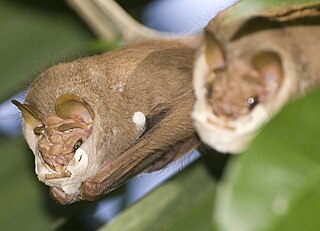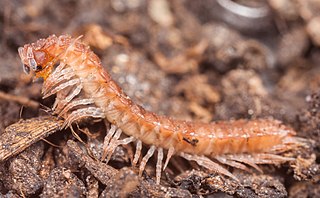
Anton Ausserer was an Austrian naturalist specialising in spiders. His father died when he was a youth, and he and his family suffered much economic hardship, but he was supported and encouraged by Camill Heller, professor of Zoology and Comparative Anatomy at the University of Innsbruck.
Camill Heller was a zoologist and anatomist.

The wrinkle-faced bat is a species of bat in the family Phyllostomidae and the only identified member of the genus Centurio. This bat is found in various countries in and around Central America. It eats fruit but is not classified within the fruit bats, and is instead classified as a leaf-nosed bat even though it does not have a leaf nose. It has an unusually shaped skull which is thought to allow it to eat a wider range of foods than other bats.

Diogenes is a genus of hermit crabs.
Zozymodes is a genus of crabs in the family Xanthidae, and was first described in 1861 by Camill Heller.

Mesoniscus is a genus of woodlice, placed in its own family, Mesoniscidae, and section, Microcheta. It contains two species – Mesoniscus alpicolus and Mesoniscus graniger – that live in Central and Eastern Europe, mostly in and around caves.

Euastacus spinifer is a species of freshwater crayfish endemic to Australia that belongs to the family Parastacidae.

Exosphaeroma laeviusculum is a species of isopod in the family Sphaeromatidae, native to the west coast of southern Africa.

Brachydesmus is a genus of millipedes belonging to the family Polydesmidae. The Czech zoologist Camill Heller first described this genus to contain the type species B. subterraneus. This genus now includes about 75 described species.
Walkeria tuberosa is a species of colonial bryozoan in the order Ctenostomatida. It is native to the Mediterranean Sea, and has spread to the Red Sea and the Indo-Pacific region.

Ascidia incrassata is a sea squirt in the family Ascidiidae and was first described in 1878 by Camill Heller.
Ascidia caudata is a sea squirt in the family Ascidiidae and was first described in 1878 by Camill Heller.
Caligus infestans is a species of sea louse in the family, Caligidae, first described by Camill Heller in 1865.
Diogenes avarus is a species of left-handed hermit crab first described in 1865 by Camill Heller.

Herdmania grandis is a species of sea-squirt in the family Pyuridae.

Halopteris diaphana is a species of hydroida first described in 1868 as Anisocalix diaphana by Camill Heller.

Asterocarpa humilisis a species of ascidian first described in 1878 as Styela humilis by Camill Heller.
Herdmania pallida is a species of sea-squirt in the family Pyuridae.

Microscosmus exasperatus is a species of tunicate in the family, Pyuridae, and was first described in 1878 by Camill Heller.

Pyura gibbosa is a species of sea-squirt in the family, Pyuridae, and was first described in 1878 as Cynthia gibbosa by Camill Heller.













